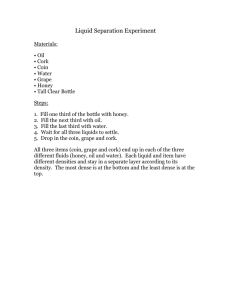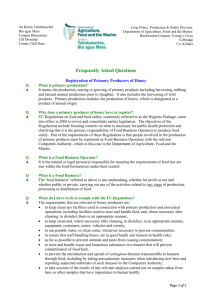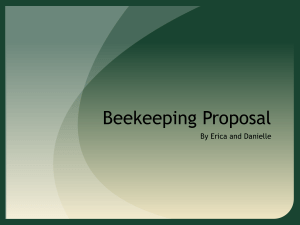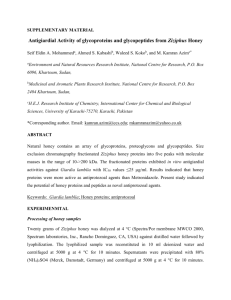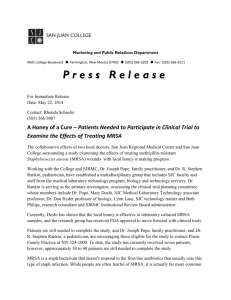Memories
advertisement
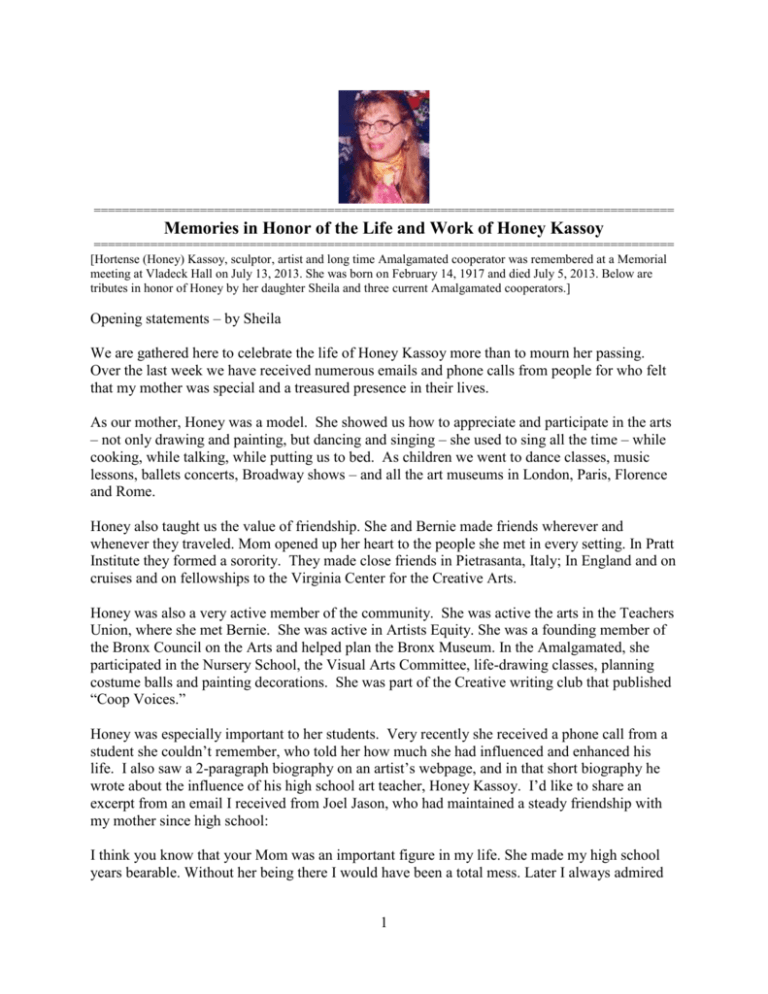
================================================================================== Memories in Honor of the Life and Work of Honey Kassoy ================================================================================== [Hortense (Honey) Kassoy, sculptor, artist and long time Amalgamated cooperator was remembered at a Memorial meeting at Vladeck Hall on July 13, 2013. She was born on February 14, 1917 and died July 5, 2013. Below are tributes in honor of Honey by her daughter Sheila and three current Amalgamated cooperators.] Opening statements – by Sheila We are gathered here to celebrate the life of Honey Kassoy more than to mourn her passing. Over the last week we have received numerous emails and phone calls from people for who felt that my mother was special and a treasured presence in their lives. As our mother, Honey was a model. She showed us how to appreciate and participate in the arts – not only drawing and painting, but dancing and singing – she used to sing all the time – while cooking, while talking, while putting us to bed. As children we went to dance classes, music lessons, ballets concerts, Broadway shows – and all the art museums in London, Paris, Florence and Rome. Honey also taught us the value of friendship. She and Bernie made friends wherever and whenever they traveled. Mom opened up her heart to the people she met in every setting. In Pratt Institute they formed a sorority. They made close friends in Pietrasanta, Italy; In England and on cruises and on fellowships to the Virginia Center for the Creative Arts. Honey was also a very active member of the community. She was active the arts in the Teachers Union, where she met Bernie. She was active in Artists Equity. She was a founding member of the Bronx Council on the Arts and helped plan the Bronx Museum. In the Amalgamated, she participated in the Nursery School, the Visual Arts Committee, life-drawing classes, planning costume balls and painting decorations. She was part of the Creative writing club that published “Coop Voices.” Honey was especially important to her students. Very recently she received a phone call from a student she couldn’t remember, who told her how much she had influenced and enhanced his life. I also saw a 2-paragraph biography on an artist’s webpage, and in that short biography he wrote about the influence of his high school art teacher, Honey Kassoy. I’d like to share an excerpt from an email I received from Joel Jason, who had maintained a steady friendship with my mother since high school: I think you know that your Mom was an important figure in my life. She made my high school years bearable. Without her being there I would have been a total mess. Later I always admired 1 both your parents love of life. Their ability and desire to travel and their creativity was always inspirational. Honey was a model for us how to be a loving mother and life partner while not sacrificing a life filled with her own interests and pursuits. She did it all. Things you might not have known about Honey Kassoy: When her mother was teaching her to write her name for the first time and said to write “h-o-r,” Honey told her that she was wrong and the next letter was “n.” That was when she found out her name was Hortense. Mom graduated from high school a month short of her 15th birthday. She found out she was a sculptor when she took a summer class in sculpture at Cornell – because it fit in her program! She studied sculpture with Chiam Gross. As a young woman, she ran around to night clubs with her cousin Veni. She had an incredible memory for songs lyrics, and won a Name that Tune type contest. She loved the blues, Cole Porter, Gershwin and show tunes. At a Newspaper Guild party in 1942 or so, the evening ended with Honey jamming- singing with the piano played by Art Tatum. Josh White told her she was only the second white woman he had ever heard who could sing the blues. She was subsequently offered a job singing at a club in Greenwich Village. She turned it down. Honey sang and danced in Teachers Union productions where she met Bernie at a rehearsal, in Amalgamated Nursery School shows, in community theaters including a show at the Veterans center on Orloff Avenue, the APRICOT (Amalgamated) production of Fiddler on the Roof, and other productions upstate. Honey was the second person to perform “Strange Fruit,” the first being Ann Meeropol, and she sang it at Abel Meeropol’s memorial. For decades, she did the NY Times Sunday puzzle – in ink! I’ve left out a lot, but there is just too much for words. Sheila Krstevski ----------------------------------------------------------------------------------------------------------------------------- --------------HONEY KASSOY My name is Elizabeth Grachev. I am a professional artist, but in America I was working as a programmer at Lehman College for 18 years. My husband Yuri Grachev, myself and our daughter Maria left Russia in 1977 and 8 months later, in April of 1978 entered the US. The same year, my sister with her family came here. For the first six months we lived together in one apt — in the Amalgamated co-op. We were lucky to find ourselves in the Amalgamated — we moved into a two bedroom apartment in August 1978, just three months after our arrival to JFK airport — such luck should be underlined. If not the Amalgamated, — who knows how different our lives could be. 2 The first people we met here were a group of artists and intellectuals — it helped —since we were not alone in, to us, an unknown world. And who were those people — Bernie and Honey Kassoys, their daughter Sheila who spoke Russian language, then Etta and Al Goldbaums, Bernie Olshan, Judah Goldstein. All of them were knowledgeable people and talented individuals — they were poets, they played musical instruments, they had an ear for music and they were great singers — like Honey and Etta. Since our family was like our new friends — we were singers, artists who loved literature — it was obvious that we got into a perfect for us place to live here. The only thing was that we escaped the socialism in Russia— in reality an equal sharing of misery and got to come here into capitalism with much better conditions of life. Almost from the start we were bombarded by our new friends with questions about socialism and life in Russia. Of course there were some discrepancies — we lived in different social systems. Our friends (not all of course) believed in communism and better life for working class, and we tried to convince them that there was no socialism in Russia, only bloody dictatorship. Then, Honey, Bernie and the whole family decided to visit Russia and see the situation with their own eyes —and they did it in May of 1983. They even visited my mother’s family in Moscow and brought back pictures of her family. Today we are remembering Honey as a talented artist, as participant in many activities here, as a real activist in the life of the Amalgamated Co-op. Honey, Bernie and all the other people I already named were the Mohicans of our Cooperation and this is my tribute not only to Honey but to all of them. They were the soul of the artistic life and creativity here. They worked hard for the Artist Costume Balls — such an activity through many years can’t be repeated — there is not that flame left anymore. The creation and performances in 1988 of Fiddler on the Roof was the peek in Amalgamated history. The production involved 92 people and attracted 1000 spectators for its six performances. And all artists, Honey and Bernie — all were burning with the desire to create. That spirit of that time can’t be restored here. I remember the day of performance very well — there was a moment of great unity during that performance when artists were singing, Judah Goldstein playing piano, lighting candles in complete darkness, audience with bated breath — and complete stillness. It was a great moment. I remember the 1988 New Year celebration in Kassoy’s apartment. My husband Yuri Grachev was playing guitar and we were singing, singing and singing. Incredible night. Honey was strong in her life — it is difficult for a woman to be a sculptor. Her husband Bernie should be a sculptor, but he was attracted by poetry and was a romantic, — painting in an impressionists-like, but his own way. Honey had the courage to create her art independently of an art market, and thus she was freed and did what she wanted. She created her art in her own right in our complex artistic world. Unfortunately, it is impossible to get recognition in art world where art became a business. And this is a big concern for the society which lost many of its talents due to greed, fashion and intoxication in life and art. We had artists, musicians here — but who knows who Judah 3 Goldstein was? I think all names I mentioned must not be forgotten — at least a panel with their images and names and who they were in the Amalgamated history — must be installed. We, who knew Honey, Bernie, Etta and all other artists who contributed their soul, their time we remember them — but when we are not here anymore? Who will remember them? Amalgamated helped greatly its artists when it gave them studios at low cost to work in. It seems to me, together with the History Club the Amalgamated should have the series of those artists exhibitions here at Vladeck hall and, if not the original art shown, but at least slide show, films or even photos or reproductions. Amalgamated should not let the very rich history of its wonderful artist community be lost. Farewell to Honey and Bernie — they were together — and we remembering them together. Elizabeth Grachev --------------------------------------------------------------------------------------------------------------------Jay Hauben I want to share some of my memories of my friend Honey Kassoy: I knew about the Kassoys from my brother Danny who had told me about a lively and talented artist community at Amalgamated. When Bernie Kassoy, died I spoke briefly at the memorial service and introduced myself to Honey. Afterward, whenever I saw Honey, I said “Hello Honey. This is Jay Hauben.” At first she always asked "WHO??" I said Danny's brother. Then we talked a bit and she told me she was doing ok. When the History Club sought to interview cooperators living here now who moved into their buildings in 1949-51, we found out Honey was still the occupant of the apartment her family had moved into in Bldg 8 in 1950 when it was new. Six members of the History Club were fascinated when in Feb 2011 we interviewed her in her apartment about what it was like when she moved in 60 years ago. She told us she danced with joy when she entered the large living room and envisioned living there. By the time there was a second daughter and she and Bernie were active artists, using one bedroom as a studio and sleeping in the living room it did not seem so large. Amalgamated came to the rescue and give her and Bernie a space in the basement which Honey and Bernie made into their studio giving them back a bedroom. But Honey had so much more to tell us about, like the Gay Nineties Nursery School Review fund raiser and the Artist Costume Balls, the production and performances of Fiddler on the Roof and especially about the Co-op Voices workshops producing the wonderful literary and sketches magazine that was put out in the 1990s. Honey explained that she and Bernie felt part of a wonderful community and were happy to give what they could back to it. The History club included her stories in our celebration of the 60th anniversary of the middle generation buildings and we invited her to make a presentation at one of our meetings. The meeting was one of our most interesting. At the end, Honey made suggestions that we invite people like George and Theresa La Marca about theater and Lew Levin about music so we club members would have a fuller picture of Amalgamated but also, that we might attract again 4 creative people to be active at Amalgamated. For 2 years Honey and I kept up the discussion about what to do to attract increased cooperator involvement especially younger people. Honey was an active participant in the Education Department meeting in early 2012 discussing the question "What would the founding fathers of Amalgamated think of how our co-op is doing today?" She stressed the need for more efforts to try every possible activity and have as many programs as possible. It was for me a great treasure to know and work with Honey. Her life is an inspiration of creative activity and concern for Amalgamated. I will remember Honey fondly. I already miss her. Jay Hauben -------------------------------------------------------------------------------------------------------------------Ronda Hauben A tribute to Honey Kassoy For me it is sad to see the passing of Honey Kassoy Honey gave me several gifts that I want to reflect on today. Her long life was a special treasure as she not only was part of important struggles and efforts, but she lived long enough to be able to pass these experiences and lessons on to others. I did not get to know Honey until after Bernie died. I had heard of her and of Bernie but sadly had not known either of them. Fortunately it was possible to interview Honey about her experiences at Amalgamated as part of the activities I was involved with in the Cooperative History Club. It was a delight to hear Honey share experiences she had been part of, not only as an artist at Amalgamated, but also working on a literary magazine "Coop Voices" that several Amalgamated people worked on in the 1990s. From the experiences that Honey shared of the activities and efforts of the Amalgamated artists group, it became clear that the struggle for a cooperative requires that there be activities that make it possible for people to work together toward becoming more cooperative. The Artists Costume Balls held for several years in the 1980s and into the 1990s provided an environment for not only high quality creative artistic work, but also for a way for the artists and others who participated to work together to plan, create the art work, and hold the evening events. Similarly, the Coop Voices literary magazine that several cooperators worked on provided a means for cooperators to share their literary works with each other and hear the comments of others toward producing a final version of their articles which were then published in issues of Coop Voices. 5 It is important to realize that not only was Honey a significant artist, but she was also a pioneer in contributing to a cooperative artists community. In Honey's living room she has had on display several sculptures she did of cooperative efforts of people. These are a special symbol of the cooperative artistic environment that Honey both helped to build and in turn was nourished by. These sculptures and the many cooperative artistic efforts Honey was part of are a symbol of the cooperative vision of the pioneers who began Amalgamated and the demonstration that their vision has been embodied in the experiences and artistic endeavors of a set of cooperators. Ronda Hauben 7/13/2013 =================================================================== 6


